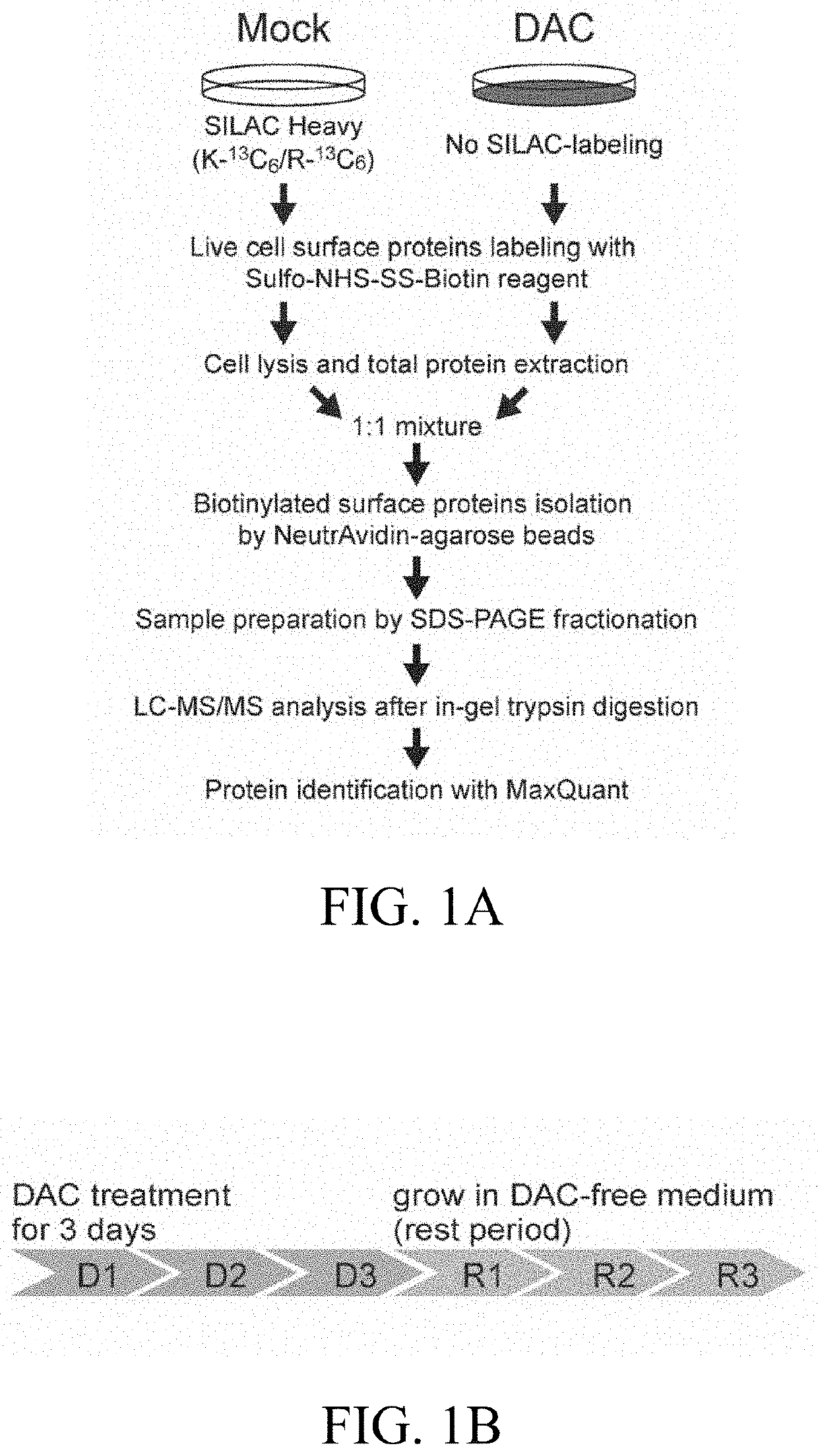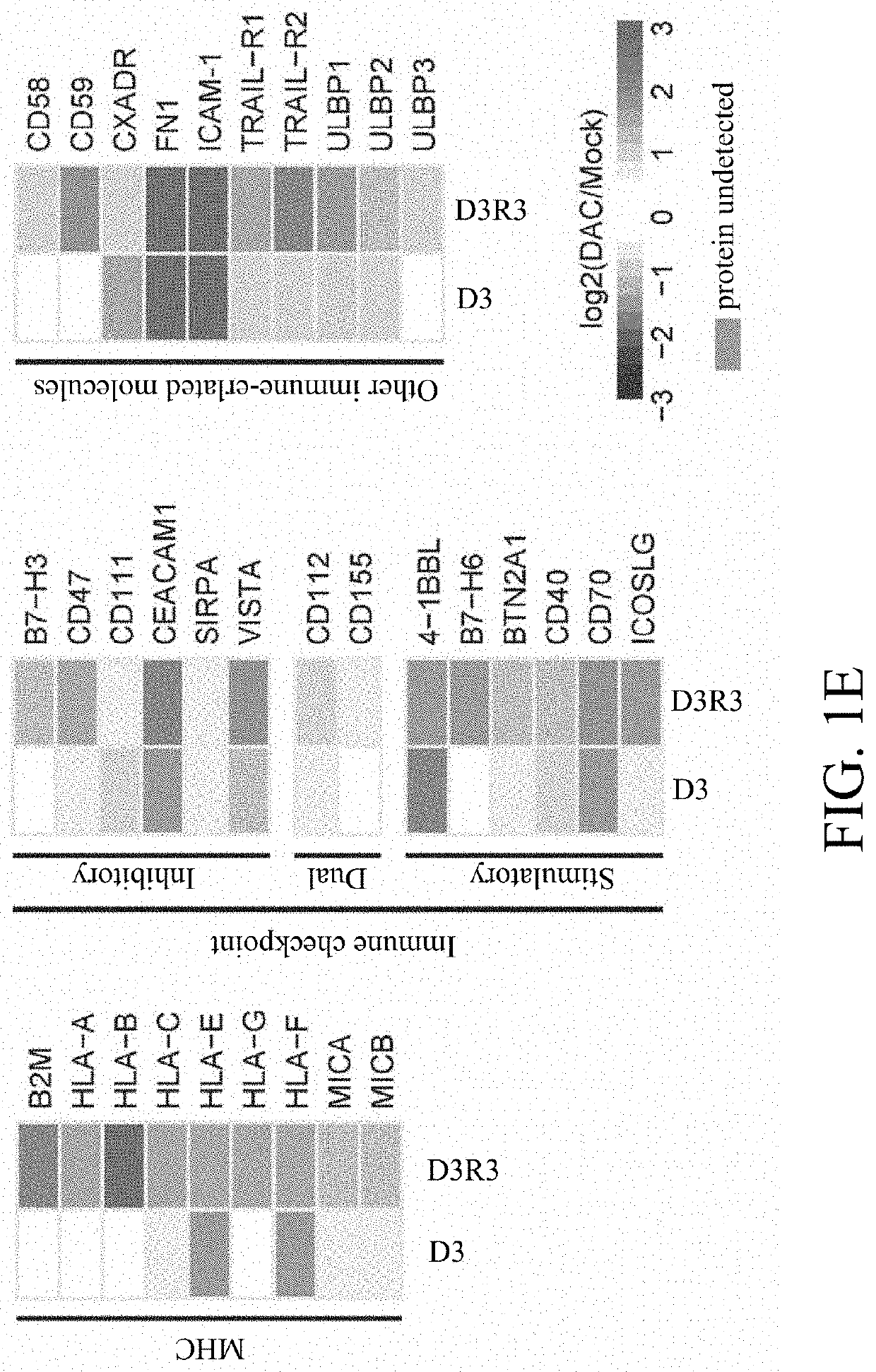Method for treating cancer
a cancer and cancer technology, applied in the field of cancer treatment or treatment, can solve the problems of limited efficacy of autologous or allogeneic t cells, and achieve the effect of reducing the methylation level of the promoter dna of the gene of the actin cytoskeleton
- Summary
- Abstract
- Description
- Claims
- Application Information
AI Technical Summary
Benefits of technology
Problems solved by technology
Method used
Image
Examples
example 1
reases Surface Immune Molecules Related to γδ T Cell Activation
[0062]Two FDA approved DNMTis, decitabine (Dacogen, DAC) and azacytidine (Vidaza, AZA), are cytidine analogs that incorporate into DNA / RNA and deplete DNMTs through irreversible binding of the enzymes followed by proteasome degradation. In this example, DNMTis were shown to induce the alterations of surface proteins that account for susceptibility to immunotherapy.
[0063]Specifically, procedures to obtain a comprehensive profile of surface proteins altered by decitabine (DAC) through isolating cell surface proteins from A549 human lung cancer cells before and after DAC treatment using the EZ-link Sulfo-NHS-SS-biotin-assisted biotinylation method, followed by a SILAC-based quantitative proteomic approach were shown in FIG. 1A.
[0064]A low-dose treatment protocol was established to manifest the drug's epigenetic effects over cytotoxicity, as shown in FIG. 1B, and identified 666 and 831 Gene Ontology (GO)-annotated surface pr...
example 2
xpanded Human Vδ1-Enriched γδ T Cells Retain Antitumor Effector Functions
[0069]Based on the DAC-mediated surfaceome data from Example 1, epigenetic therapy has the potential to enhance tumor attack by γδ T cells. To conduct preclinical functional studies with γδ T cells for their therapeutic potential, a sequential cytokine stimulation protocol was optimized for ex vivo clinical-grade expansion of γδ T cells preferentially enriched for the Vδ1+ subset from the peripheral blood of healthy donors. The process does not require the step of initial γδ T cell purification shown previously. Over the course of 21 days, the percentage of total γδ T cells in the CD3+ cell population increased from less than 10% to over 90%, while Vδ1+ T cells accounted for approximately 70% of all γδ T cells, as shown in FIGS. 2A and 2B.
[0070]To evaluate the immunophenotypes of expanded γδ T cells, single-cell analysis on PBMCs was performed at baseline and after ex vivo expansion using mass cytometry with an...
example 3
e Enhances γδ T Cell-Mediated Cytolysis of Cancer Cells
[0072]In this example, it is shown that pretreatment with low-dose DAC potentiated and increased susceptibility of cancer cells to the attack by γδ T cells.
[0073]Initially, in vitro coculture of untreated lung cancer and γδ T cells at an effector-to-target (E:T) ratio of 3:1 caused merely 20-30% cytolysis of A549 human lung cancer cells, as shown in FIG. 2H. However, 72-hour daily treatment with 100 nM DAC on human lung cancer cells (i.e., HCC827, H1299, and A549 cells) significantly potentiates the killing of lung cancer cells by γδ T cells at the same E:T ratio, as shown in FIG. 2I. On the other hand, either treatment alone resulted in minimal or moderate cell death using Annexin V and propidium iodide apoptosis assays, as shown FIG. 2J.
[0074]Similar potentiating effects were observed in several other lung cancer cell lines, including H2981, PC9, PC9-IR (Iressa resistant), H157, CL1-0, and CL1-5, as well as patient-derived lun...
PUM
| Property | Measurement | Unit |
|---|---|---|
| concentration | aaaaa | aaaaa |
| pH | aaaaa | aaaaa |
| internal diameter | aaaaa | aaaaa |
Abstract
Description
Claims
Application Information
 Login to View More
Login to View More - R&D
- Intellectual Property
- Life Sciences
- Materials
- Tech Scout
- Unparalleled Data Quality
- Higher Quality Content
- 60% Fewer Hallucinations
Browse by: Latest US Patents, China's latest patents, Technical Efficacy Thesaurus, Application Domain, Technology Topic, Popular Technical Reports.
© 2025 PatSnap. All rights reserved.Legal|Privacy policy|Modern Slavery Act Transparency Statement|Sitemap|About US| Contact US: help@patsnap.com



